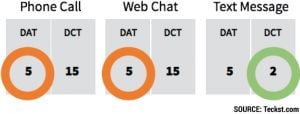For consumers, the benefits of texting for customer service are obvious. Whether it’s tracking a food delivery or needing to change a flight, customers expect to have their questions answered and their issues resolved quickly. Of all the customer service channels, texting has proven to be the most convenient, least time-consuming and preferred mode of communications.
Some companies continue to be laggards when it comes to incorporating texting, and others that have embraced it as a channel aren’t effectively measuring the channel because, well, it’s so new that not a lot of yesteryear’s metrics work for texting.
It’s time to evolve and consider new customer service metrics. These new metrics bring new insights into the time-saving and experience-boosting benefits for building an incredible customer experience.
Dedicated Time (DT) is, simply, the time dedicated to a conversation. Determining DT combines Dedicated Agent Time (DAT) and Dedicate Customer Time (DCT):

DAT measures the amount of time (in minutes) an agent spends on an individual conversation. Keeping in mind that an agent could handle the bandwidth of multiple conversations at once – but aren’t necessarily active on every single one at all times – determining DAT also requires a mixture of metrics. This number takes into account the time a window is active, the average read time and how long it takes to type and send a response.
DCT assesses the amount of time (in minutes) a customer is strictly looking at their screen and not engaging in another activity. Traditional customer service channels like phone and web chat require a dedicated connection, while mobile customers may go about their business and use other apps at the same time as being on a service text. For that reason, DCT looks at how much time a customer spent on the conversation itself, and can also factor in type time.
How to measure Dedicated Time
At Teckst, our clients that are utilizing DT combine a range of factors, from time on ticket to time to resolution for DAT, and word count/length and pause time for DCT. These methodologies are still being worked on. However, we have found a direct correlation between reduced DT and increases in NPS.
While the instant attributes of texting speeds up the customer service process, a conversation may still take 15 minutes or more before an agent can resolve the issue. However, the actual time spent by both the agent and the customer rings in far below that of other channels. Plus, in this time, the customer has not been locked down to a screen or tied to a phone connection – they are free to carry on with their day.
The new texting metrics reinforces what customer feedback has already taught us: SMS customer service reduces time to resolution, is super convenient and is quickly becoming the favorite service channel for consumers and companies everywhere.



